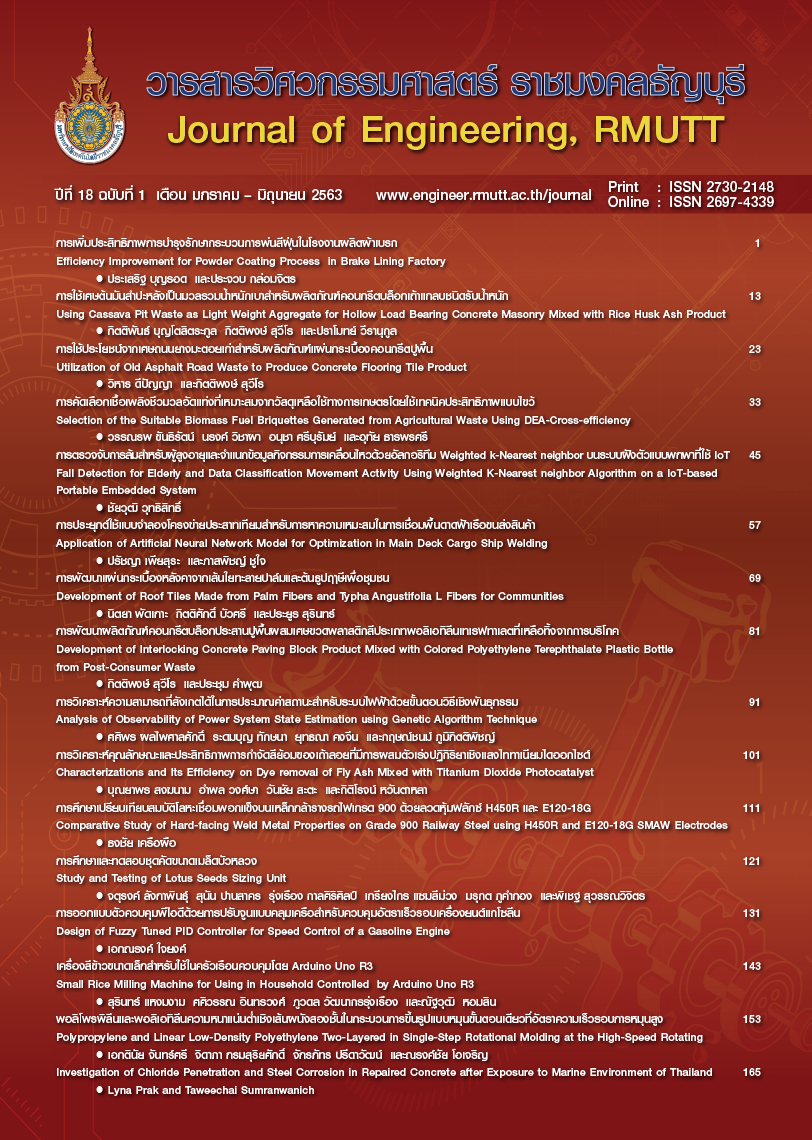Application of Artificial Neural Network Model for Optimization in Main Deck Cargo Ship Welding
Main Article Content
Abstract
This research proposes the optimization of main deck cargo ship welding with submerge arc welding process (SAW) in high strength steel ASTM A131 EH36 grade. The mathematic modeling for tensile strength predicting was based on the artificial neural networks (ANN) with back-propagation learning algorithm and supervised learning. The SAW process parameters were studied the welding current, voltage and travel speed. The resulting SAW welding specimens were examined using tensile strength tests, bending tests which were observed microstructure with scanning electron microscopy (SEM) and determine a suitable mathematic model. The Levenberg-Marquart training algorithm was also train for weight and bias network. The two learning function, including learning gradient descent (Learngd) and learning gradient descent with momentum (Learngdm) were used in ANN model. The activation function of log-sigmoid for input layer, tan-sigmoid for hidden layer of 1 and 2, purelin for output layer was assigned. The research results reveal that using a ANN model with the proposed mathematical model, which represents 3 neurons for the input 8 neurons for layer 1 layer 2 for 10 neurons and 1 neuron for output layer (3-8-10-1) with learning function of Learngd. The mean square error (MSE) of ANN model is 0.000106 and the coefficient of determination (R2) is 0.99947. The optimum from ANN model were welding current of 340 amperes, 26 volts, and 20 centimeter/minute travel speed.
Article Details
The manuscript, information, content, picture and so forth which were published on Frontiers in engineering innovation research has been a copyright of this journal only. There is not allow anyone or any organize to duplicate all content or some document for unethical publication.
References
Wanchai M, Sumalee S, Suphattra l, Sompong S, Pramuan B, et al.Integrateddevelopment of shipbuilding and ship repairing industry: Executive summary. Transportation Institute, ChulalongkornUniversity. 2007(in Thai)
Tanawat S, Vithaya R,KittichaiS.Submerged arc welding process and ship building industry. The Journal of Welding Institute of Thailand. 2016;2(1):30-5. (in Thai)
Luiz H. S. B., Paulo J. M., Leonardo B. G. and Ariel R. A.Fatigue crack growth rates on the weld metal of high heat input submerged arc welding International,Journal of Fatigue 2019; 119: 43–51.
Layus P, KahP, Khlusova E,Orlov V.Study of the sensitivity of high-strength cold-resistant shipbuilding steels to thermal cycle of arc welding.International Journal of Mechanical and Materials Engineering. 2018; 13(3):1-9.
Tadeu M, Donizete B, Wagner D. F,LeonardoD. O. T,Ronaldo C. J.Assessmentof the weldability of EH36 TMCPshipbuilding steel welded by high heat input submerged arc welding, Welding International. 2017; 31(3):184-95.
Rong Y,Mi G,Xu J,Huang Y, Wang C.Laser penetration welding of ship steel EH36: A new heat source and application to predict residual stress considering martensite phase transformation, MarineStructure. 2018; 61:256-67.
X. R. Li, Y. M. Zhang,L. Kvidahl.Penetrationdepth monitoring and control in submergedarc welding, Welding Research. 2013; 92: 48-56.
Carole E, David T, Jean-Yves C, Manuel K.Fatigue life prediction of welded ship detail, Marine Structures, 2012;25(1): 13-32.
Liangbi L, Xiaomei G, Shaolong S, Wenjie W, Zhengquan W. et al.Effects of welding residual stresses on the vibration fatigue life of a ship's shock absorption support, Ocean Engineering. 2018; 170: 237-45.
Ke Z, Yixin C, Jian Z, Jian H,Xinhua T.Adaptive filling modeling of butt joints using genetic algorithm and neural network for laser welding with filler wire. Journal of Manufacturing Processes.2017; 30: 553-61.
A. Bagchi, S. Saravanan, G. Shanthos Kumar, G. Murugan,K. Raghukandan.Numerical simulation and optimization in pulsed Nd: YAG laser welding of Hastelloy C-276through Taguchi method and artificial neural network. Optik. 2017;146: 80-9.
A. Sarka, P. Dey, R. N. Rai,S. C. Saha.A comparative study of multiple regression analysis and back propagation neuralnetwork approaches on plain carbon steel in submerged-arc welding. Sadhana,2016; 41(5): 549–59.
L. Yu, K. Saida, S. Hirano, N. Chigusa, M. Mochizuki,K. Nishimoto.Application of neural network-based hardnesspredictionmethod to HAZ of A533B steel produced by laser temper bead wel-ding. Welding in the World, 2017; 61(3): 483–98.
D. Zhao, D. Ren, K. Zhao, S. Pan,X. Guo.Effect of welding parameters on tensile strength of ultrasonic spotwelded joints of aluminum to steel by experimenttation and artificial neuralnetwork.Journal of ManufacturingProcesses, 2017; 30: 63-74.
R.H. Myers, D.C Montgomery.Response surface methodology process andproduct optimization using designed experiments, 2 ed., USA: John Wiley and Sons: New Jersey; 2002.
American Society for Testing and Materials. ASTM E8 / E8M -16a Standard TestMethods for Tension Testing of Metallic Materials. American Society for Testing and Materials: Pennsylvania; 2013.
Montgomery DC., Design and Analysis of Experiments. USA: John wiley and son publishing, New York New; 2005.
M.S. Kaiser. Effect of heat input on the weld metal toughness of chromium-molybdenumsteel, International Journal of Chemical, Molecular, Nuclear, Materials Metallurgical Engineering. 2013;7: 33-5.
Weijun H, Yongjian Z, Xiaoli Z, Na X,Fangzhong H.High cycle fatigue behaviour of V-Microalloyed medium carbon steels:A comparison between bainitic and ferritic-pearlitic microstructures, InternationalJournal of Fatigue. 2016; 91:232-41.
Sergey G, Eva A, Maksim Z, Rudolf K, Ulrich P.Effect of spheroidization annealing on pearlite banding, Materials Science Forum, 2019; 949: 40-7.
MinwooK, Minsu J, Hyongjik L,Young-K.Microstructural evolution duringaustenitization and quenching of a 5% Cr work roll, Materials Transactions, 2012;53(11): 1915-21.
M. Saadat, A. K. E. Nobarzad, M. Jahazi.On the hot cracking of HSLA steel welds: role of epitaxial growth and HAZ grain size. Journal of ManufacturingProcesses. 2019; 41: 242-51.


